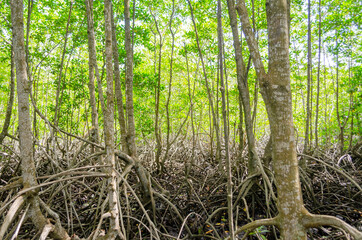
The genus Avicennia, a group of mangrove trees found in tropical and temperate regions, is a fascinating subject for evolutionary biologists. In a recent study, researchers have developed a novel computational method to estimate the time it takes for adaptive genetic changes to occur in these plants. By analyzing the DNA sequences of different Avicennia species, the researchers were able to identify genetic regions that have been under local selection, and then use this information to estimate the time it took for these adaptive changes to arise. This study provides valuable insights into the complex evolutionary processes that have shaped the Avicennia genus and how it has adapted to diverse environmental conditions across its vast geographical range.
Uncovering the Evolutionary Secrets of Avicennia
The genus Avicennia, consisting of around eight species of mangrove trees, is known for its unique adaptations to the challenging intertidal zones where it thrives. These plants have developed specialized features like salt glands, aerial and prop roots, and crypto viviparous fruits that allow them to occupy newly formed seaward mangrove habitats. Avicennia species are also economically important, as they are used for various medicinal purposes.
One of the intriguing aspects of the Avicennia genus is its extensive geographical distribution, with some species found in the Atlantic-East Pacific (AEP) region and others in the Indo-West Pacific (IWP) region. This wide range has led to variations in the species due to local adaptation and introgressive hybridization. Understanding the evolutionary pathways and adaptive mechanisms within this genus can provide insights into how plants rapidly evolve in response to changing environmental conditions.
Estimating Divergence and Adaptation Time
In the recent study, the researchers set out to achieve three main goals:
1. Estimate the species divergence time: The researchers used Bayesian-based computational methods to estimate the divergence time of Avicennia species based on nuclear (ITS) and chloroplast (trnH-psbA and trnL-F) DNA regions. This allowed them to understand how different genetic regions have evolved within the genus.
2. Identify adaptive genetic sequences: The researchers used statistical methods like Redundancy Analysis (RDA) and Latent Factor Mixed Models (LFMM) to identify genetic sequences that have potential adaptive value in response to geographical variables.
3. Introduce a new approach to estimate adaptive time: The researchers developed a novel computational strategy to estimate the time it took for the adaptive genetic sequences to evolve, by comparing the divergence time of the entire genetic regions with the divergence time of only the adaptive sequences.
Insights into Avicennia’s Evolutionary History
The study revealed several interesting findings:
– Divergence time: The researchers found that different genetic regions, such as ITS and chloroplast DNA, provided different estimates of species divergence time, ranging from 1 to 4 million years ago (MYA).
– Adaptive genetic sequences: The LFMM analysis identified several single nucleotide polymorphisms (SNPs) within the ITS and trnH-psbA regions that showed significant association with geographical variables, suggesting they have potential adaptive value.
– Adaptive time estimation: By comparing the divergence time of the entire genetic regions with the divergence time of only the adaptive sequences, the researchers were able to estimate that the adaptive ITS sequences took approximately 0.7 MYA to evolve, while the adaptive trnH-psbA sequences took about 0.9 MYA.
Uncovering the Complex Evolutionary Strategies of Avicennia
The findings of this study suggest that Avicennia’s evolution has been shaped by a combination of local adaptation and independent mutations. The researchers hypothesize that some adaptive alleles may have been present as standing genetic variation in the ancestral population, while others may have arisen through independent mutations in different geographical regions.
This complex evolutionary strategy has allowed Avicennia to rapidly adapt to the diverse environmental conditions across its vast range, even in the absence of physical barriers. The presence of both shared and independent adaptive sequences within the genus highlights the intricate mechanisms underlying the genus’s success in colonizing and thriving in the challenging mangrove ecosystems.
Implications and Future Directions
The novel computational approach developed in this study provides a valuable tool for understanding the adaptive processes in other plant groups with wide geographical distributions and diverse environmental conditions. By identifying the genetic sequences underlying local adaptation and estimating the time it took for these adaptations to arise, researchers can gain valuable insights into the complex evolutionary histories of various plant species.
Furthermore, this knowledge can inform conservation efforts and help predict how these plants might respond to future environmental changes, such as those driven by Click Here
